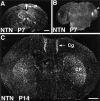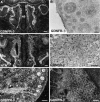Neurturin and glial cell line-derived neurotrophic factor receptor-beta (GDNFR-beta), novel proteins related to GDNF and GDNFR-alpha with specific cellular patterns of expression suggesting roles in the developing and adult nervous system and in peripheral organs
- PMID: 9334423
- PMCID: PMC6573771
- DOI: 10.1523/JNEUROSCI.17-21-08506.1997
Neurturin and glial cell line-derived neurotrophic factor receptor-beta (GDNFR-beta), novel proteins related to GDNF and GDNFR-alpha with specific cellular patterns of expression suggesting roles in the developing and adult nervous system and in peripheral organs
Abstract
Cloning strategies were used to identify a gene termed glial cell line-derived neurotrophic factor receptor-beta (GDNFR-beta) related to GDNFR-alpha. In situ hybridization was then used to map cellular expression of the GDNF-related trophic factor neurturin (NTN) and GDNFR-beta mRNA in developing and adult mice, and comparisons with GDNFR-alpha and RET were made. Neurturin is expressed in postnatal cerebral cortex, striatum, several brainstem areas, and the pineal gland. GDNFR-beta mRNA was more widely expressed in the developing and adult CNS, including cerebral cortex, cerebellum, thalamus, zona incerta, hypothalamus, brainstem, and spinal cord, and in subpopulations of sensory neurons and developing peripheral nerves. NTN colocalized with RET and GDNFR-alpha in ureteric buds of the developing kidney. The circular muscle layer of the developing intestines, smooth muscle of the urether, and developing bronchiolae also expressed NTN. GDNFR-beta was found in myenteric but not submucosal intestinal plexuses. In developing salivary glands NTN had an epithelial expression, whereas GDNFR-beta was expressed in surrounding tissue. Neurturin and GDNFR-beta were present in developing sensory organs. In the gonads, NTN appeared to be expressed in Sertoli cells and in the epithelium of the oviduct, whereas GDNFR-beta was expressed by the germ cell line. Our findings suggest multiple roles for NTN and GDNFR-beta in the developing and adult organism. Although NTN and GDNFR-beta expression patterns are sometimes complementary, this is not always the case, suggesting multiple modi operandi of GDNF and NTN in relation to RET and the two binding proteins, GDNFR-alpha and GDNFR-beta.
Figures











Similar articles
-
Cellular and developmental patterns of expression of Ret and glial cell line-derived neurotrophic factor receptor alpha mRNAs.Exp Brain Res. 1997 Jul;115(3):410-22. doi: 10.1007/pl00005711. Exp Brain Res. 1997. PMID: 9262196
-
Complementary and overlapping expression of glial cell line-derived neurotrophic factor (GDNF), c-ret proto-oncogene, and GDNF receptor-alpha indicates multiple mechanisms of trophic actions in the adult rat CNS.J Neurosci. 1997 May 15;17(10):3554-67. doi: 10.1523/JNEUROSCI.17-10-03554.1997. J Neurosci. 1997. PMID: 9133379 Free PMC article.
-
TrnR2, a novel receptor that mediates neurturin and GDNF signaling through Ret.Neuron. 1997 May;18(5):793-802. doi: 10.1016/s0896-6273(00)80318-9. Neuron. 1997. PMID: 9182803
-
Other neurotrophic factors: glial cell line-derived neurotrophic factor (GDNF).Microsc Res Tech. 1999 May 15-Jun 1;45(4-5):292-302. doi: 10.1002/(SICI)1097-0029(19990515/01)45:4/5<292::AID-JEMT13>3.0.CO;2-8. Microsc Res Tech. 1999. PMID: 10383122 Review.
-
Signal transduction by the receptor tyrosine kinase Ret.Recent Results Cancer Res. 1998;154:271-81. doi: 10.1007/978-3-642-46870-4_18. Recent Results Cancer Res. 1998. PMID: 10027007 Review.
Cited by
-
Expansion of mouse sertoli cells on microcarriers.Cell Prolif. 2010 Jun;43(3):275-86. doi: 10.1111/j.1365-2184.2010.00677.x. Cell Prolif. 2010. PMID: 20546245 Free PMC article.
-
[Research advances of artemin].Zhongguo Fei Ai Za Zhi. 2011 Oct;14(10):790-800. doi: 10.3779/j.issn.1009-3419.2011.10.05. Zhongguo Fei Ai Za Zhi. 2011. PMID: 22008109 Free PMC article. Review. Chinese. No abstract available.
-
Increased glial-derived neurotrophic factor in the small intestine of rats infected with the tapeworm, Hymenolepis diminuta.Int J Exp Pathol. 2008 Dec;89(6):458-65. doi: 10.1111/j.1365-2613.2008.00606.x. Int J Exp Pathol. 2008. PMID: 19134055 Free PMC article.
-
GFRalpha1 is an essential receptor component for GDNF in the developing nervous system and kidney.Neuron. 1998 Jul;21(1):53-62. doi: 10.1016/s0896-6273(00)80514-0. Neuron. 1998. PMID: 9697851 Free PMC article.
-
Neurobehavioral assessment of transplanted porcine Sertoli cells into the intact rat striatum.Neurotox Res. 2002 Mar;4(2):103-9. doi: 10.1080/10298420290015935. Neurotox Res. 2002. PMID: 12829409
References
-
- Angrist M, Bolk S, Halushka M, Lapchak P, Chakravarti A. Germline mutations in glial cell line-derived neurotrophic factor (GDNF) and RET in a Hirschsprung disease patient. Nat Genet. 1996;14:341–344. - PubMed
-
- Baloh R, Tansey M, Golden J, Creedon D, Heuckeroth R, Keck C, Zimonjic D, Popescu N, Johnson E, Jr, Milbrandt J. TrnR2, a novel receptor that mediates neurturin and GDNF signaling through Ret. Neuron. 1997;18:793–802. - PubMed
-
- Buj-Bello A, Adu J, Piñón L, Horton A, Thompson J, Rosenthal A, Chinchetru M, Buchman V, Davies A. Neurturin responsiveness requires a GPI-linked receptor and the Ret receptor tyrosine kinase. Nature. 1997;387:721–724. - PubMed
-
- Dagerlind Å, Friberg K, Bean A, Hökfelt T. Sensitive mRNA detection using unfixed tissue: combined radioactive and non-radioactive in situ hybridization histochemistry. Histochemistry. 1992;98:39–49. - PubMed
-
- Durbec P, Marcos-Gutierrez C, Kilkenny C, Grigoriou M, Suvanto P, Wartiovaara K, Smith D, Ponder B, Constantini F, Saarma M, Sariola H, Pachnis V. Glial cell line-derived neurotrophic factor signalling through the Ret receptor tyrosine kinase. Nature. 1996;381:789–792. - PubMed
Publication types
MeSH terms
Substances
LinkOut - more resources
Full Text Sources
Other Literature Sources
Molecular Biology Databases
Research Materials
